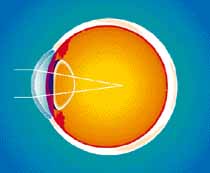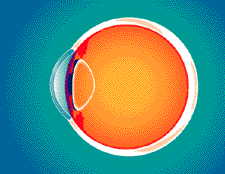RK - PRK -PARK - LASIK Defined

| Staring Into a Laser Beam RK - PRK -PARK - LASIK Defined |
 |
| --Scott Rainey | |
|
It is appropriate to define these terms and their medical slang phrases: Radial Keratotomy (RK) Slice-&-Dice is a technique popularized in the former Soviet Union where doctors are paid about $500 a month and RK surgeries are actually a lot cheaper than manufacturing eye glasses for all the people who need them. Such a policy could probably only have evolved in a centrally planned economy with a single-source health care provider system. I have heard reports that I consider reliable that there was also an issue of "trade deficits." The Supreme Soviet didn't want to buy a lot of eyeglasses from the dominant supplier within the former USSR - East Germany - due to balance of payment considerations. RK surgeries are performed there in "surgical factories." Patients lie on rolling gurney's which move on tracks from doctor to doctor; each doctor performing the various steps of the operation in much the same way Henry Ford brought separate specialized tasks to the automobile factory floor. RK is a series of "radial" cuts into the cornea of the healthy eye. These very accurate cuts cause the tissues of the cornea to fold over changing the optical geometry of the cornea in a predictable manner which ultimately causes an ophthalmological correction. The slits are not in your field of vision, but are at the outskirts of the cornea where the colored part of your eye is usually seen. People with astigmatism can be treated with RK which simply requires additional slits to cause correction for the non-spherical aspect of the required correction. Many hundreds of thousands of these surgeries have been performed in the former Soviet Union, and many tens of thousands have been done here in the USA. A friend had this surgery done in the USA in early '97 for $800-both eyes and reported a recovery period of a few days. The downside risk to RK is that the cornea is a group of transparent living cells that are perfectly parallel; and in RK, some of these cells are folded over at right angles to their original orientation. Think of the pages of a book closed and open. Some patients (including everyone I know who's had RK) report star-burst effects from bright lights at night when their pupils are open the widest. Photo Refractive Keratotomy (PRK) (Zap) uses an Excimer laser to evaporate the cells at the center of the cornea, under computer control. This technique simply changes the geometry of the cornea to reduce or eliminate the need for glasses or contact lenses. Photo Refractive Keratotomy w/Astigmatism Correction (PARK) uses the same Excimer laser as PRK, but adds an algorithm to compensate for the non-spherical nature of some corneas commonly known as astigmatism. Laser Assisted in Sieu Keratomileusis (LASIK) (Flap-N-Zap) is a variation on PRK. In LASIK the surface cells are peeled off, like the skin of a grape, but left attached. The cells under this "flap" are zapped with an excimer laser then the flap is replaced. Initial healing with LASIK is a lot faster than PRK, but total healing takes about the same time. Dr. Rich thinks LASIK is over-rated, even though he does both, and chose PRK for his own eyes in early '97. With LASIK there is a greater contamination risk than with PRK. We often forget how much dust there is in the air everywhere. If a speck of dust gets under the LASIK flap there will be complications to the surgery.. During the summer of 1997, LASIK and PRK cost $1,900 per eye in Portland Oregon. |
Home Page
|
 Focus problem in a nearsighted (myopic) eye |
 Animated GIF of PRK process (91k) |